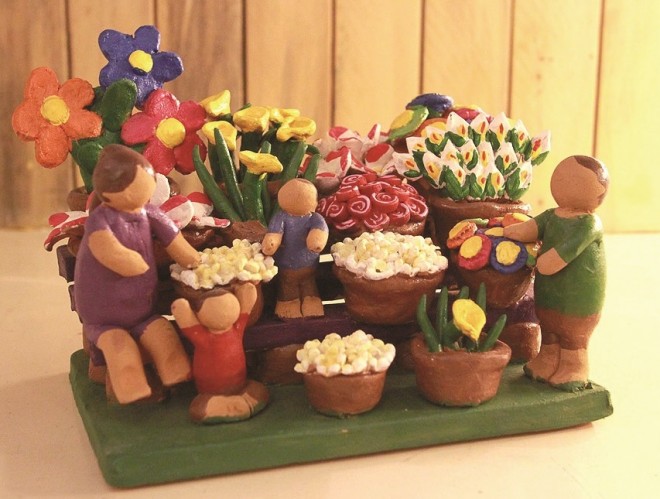
From a reporter of social history to a visual storyteller of life in Laguna, An Mercado-Alcantara has found greater fulfillment in mid-life as a potter-artist.
She is the first featured artist in Tesoro’s “Disenyo at Talento,” a series of collections for the landmark handicrafts store that features up-and-coming artists and artisans who interpret Filipino and Spanish heritage in their works. Alcantara’s style is akin to Naïve Art—works of artists who eschew the realistic depiction of a subject and formal rules of aesthetics.
Listening dolls
Alcantara’s terra-cotta figures and tablets portraying life in her hometown, San Pablo, referred to the art of the late Native American pottery storyteller artist Helen Cordero who lived in Cochiti Pueblo New Mexico, where pottery was part of woman’s duty.
Instead of making pots and vases, Cordero shaped figures with smaller figures, called listening dolls, who clung to the former. Ten years ago, Cordero’s storyteller dolls were classified as Native American art that required documents of authenticity and fetched more than $18,000.
Alcantara adapted Cordero’s style, drawing inspiration from San Pablo where people love to engage in storytelling. One of her subjects, Boni Mag-iibon, was a bird vendor who whistled calls so that birds would perch on his shoulder. The practice is now illegal; the storyteller figure was just one of the many vignettes that captured the vanishing provincial life.
Luis Magwawalis was a reference to the houseboy of her husband’s grandmother who often rested under a tree. The lola would chide him and get him sweeping the grounds again. Other terra-cotta storytellers portray vendors with children holding on to them.
Then there’s the Sta. Maria series, storyteller figures of the various attributes of the Virgin Mary.
Alcantara’s other series are similar to the Latin American folk art that portrays religious beliefs and secular life. Like three-dimensional paintings, the retablos or carved niches and tablets depict individually handcrafted figures in a complicated background of fiestas and processions.
One of her popular works is the Our Lady of Antipolo appearing on a tree, surrounded by pilgrims and vendors selling the town’s specialties such as suman, cashew and sampaguita garlands.
The artist compares the facelessness of her storyteller figures to Waldorf dolls whose lack of expression allows the child to express creativity. Alcantara said putting facial details tended to limit the expression of storytellers, and it was up to the viewer to find meaning in the work.
“If it’s faceless, it can expand and capture what you would like it to represent,” she said.
Her transition from journalist-media executive to artist came naturally. She started out as a lifestyle reporter for the now defunct Manila Chronicle in 1987 and left ABS-CBN Publishing as editorial director in 2013. She said she’s always been a country girl at heart despite the slick lifestyle she was exposed to.
Her husband of 21 years, Jose Cayetano “Boots” Alcantara, hails from San Pablo, which eventually became her adopted city. In 1997, they set up a bed and breakfast place, Casa San Pablo, where they enjoy playing the roles of innkeepers.
Tactile quality
She discovered sculpting when she would join her son, Diego, in his claymaking sessions. “When he was done, I’d still be playing,” she recalled. She was turned on by the tactile quality of the material, and felt some connection with it. She took lessons with such potter-artists as Lanelle Abueva-Fernando, Ugu Bigyan and John and Tessy Pettyjohn.
With dental tools and clay shapers, she would create figures inspired by real people in San Pablo. The storyteller figures would be sold at Casa San Pablo.
Eventually the storytellers found their way to bazaars and the MaARTe Artisan Fair, where she received voluminous orders. Collectors were buying the Puto Bumbong storytellers, The Nativity tableaux, replete with children and farm animals, and the Our Lady of Guadalupe retablos.
Seeing the business potential of her art, Alcantara decided it was time for a second wind after 26 years in journalism.
“It may sound like a cliché but you have to follow your heart,” she said. “I’m lucky to have a very supportive husband and another business to support my passion.”
She is also president of San Pablo’s tourism council.
Today she works with four other artisans who create terra-cotta pieces that narrate the story of the simple life in the province.
She noted that she didn’t want to venture into mass production to maintain the folk art spirit of her storytellers. She has trained four artisans to help her. “My hope is that this will someday be folk art.”
An-Mercado Alcantara’s work will be featured at Tesoro’s this July. Visit casasanpablo.com